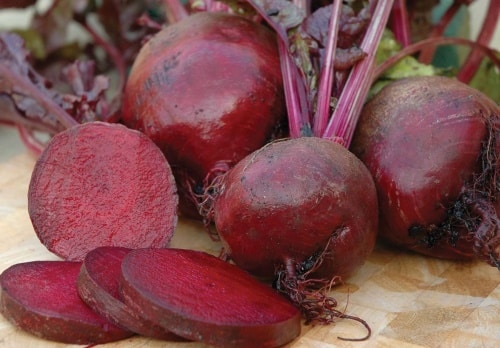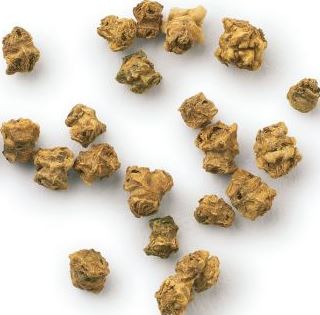Beetroot Cultivation Guide:
Introduction of Beetroot Cultivation:- Beetroot is one of the hardy and cool season vegetable crops grown throughout the world. The beetroot vegetable is indigenous to Asia and Europe. Beetroot is grown all over the world in temperate regions and the leaves of beetroot plant are heart shaped. The stem of beetroot plant is short and plate. The beetroot is a true biennial, producing thick root system and a rosette of leaves during the 1st year and flowers and seeds the 2nd year. Beetroot has wonderful health benefits and one can obtain good profits in 3 to 4 months with proper vegetable crop management practices. Beets can be grown indoors and in containers, polyhouse and greenhouse.
Scientific Name of Beetroot:- Beta vulgaris.
Family Name of Beetroot:- Chenopodiaceae.
Common Names of Beetroot:- Common beet, Beetroot, Table beet, Garden beet, Red beet, or Golden beet.
Local Names of Beetroot in Various Countries:- Beetroot (English), Rode biet (Dutch), Rote Bete (German), улаан манжин (Mongolian), Burak (Polish), Biotais (Scottish), Baytaraaf (Somali),چقندر (Urdu), Panxhar (Albanian), Cvekla (Bosnian), Punapeet (Estonian), παντζάρι (Greek), 근대의 뿌리 (Korean), Pitravi (Maltese), Chukander (Nepali), Beterraba (Beterraba), цвекле (Serbian), Remolacha (Spanish),الشمندر (Arabic), цвекло (Bulgarian), 甜菜根 (Chinese), Remolacha (Filipino), Barbabietola (Italian), Chawanar (Kurdish), Hóngtóu cài (Mandarin), Rødbete (Norwegian), Pak gaat deang (Thai), rể củ cải (Vietnamese), ճակնդեղ (Armenian), Cikla (Croatian), テーブルビート(Japanese), Biete (Latvian), Sfeclă (Romanian), බීට් අලය (Sinhalese), Tini (Swahili), Řepa červená (Czech), Betterave (French), Chukander (Hndi,India), Cveklo (Macedonian), свекла (Russian), Repa obyčajná (Slovak), Beta (Swedish), Kırmızı Pancar (Turkish), Rødbede (Danish), ჭარხალი (Georgian), Cékla (Hungarian), Ubi Bit (Malay), چغند (Persian), Navadna pesa (Slovenian), 甜菜的根 (Taiwanese), Буряк (Ukrainian).
Health Benefits of Beetroot:- The following are some of the health benefits of beetroot.

- Beetroot is excellent source of vitamins and minerals.
- Beetroot is heart healthy and can reduce stroke and blood pressure.
- Beetroot is wonderful antioxidant.
- Beetroot helps in controlling blood cholesterol.
- Beetroot helps in controlling blood sugar levels.
- Beetroot is excellent anti-ageing produce.
- Beetroot helps in weight management.
- Beet is good for brain health.
- Beetroot is good for skin and hair health.
- Beetroot helps in detoxifying blood.
Cultivars (Varieties) of Beetroot:- Crimson Globe (Comes to harvest in 2 to 3 months), Detroit Dark Red (Comes to harvest in 2 to 3 months) and Red Ball are most grown varieties. Find out with local horticulture department for improved/hybrid varieties specific to your region.
Climate Requirement for Beetroot Cultivation:- Basically beetroot is a hardy and cool weather crop which can even tolerate some freezing climatic conditions. The ideal temperature for beetroot crop is about 18 to 25 °C. It does not thrive well in extreme hot and extreme cold weathers. Spring and autumn are the best seasons for its production.
Soil Requirement for Beetroot Cultivation:- Beetroot vegetable can be grown in any friable soils. However, it thrives best on deep and well-drained, loose, loamy to sandy soils. Avoid heavy clay soils for growing this vegetable. The best suited soil pH for beetroot cultivation is 6.0 to 7.0. Acidic soils should be avoided or limed to raise the soil pH. In case of commercial cultivation of beetroot, go for soil test before planning for it.
Land Preparation for Beetroot Cultivation:- Give couple of ploughings to bring the soil to fine tilth stage and cross harrowing to make sure to have friable and levelled soil for preparing ridges and furrows. Ridges and furrows should be formed at 30 cm apart. If the Beetroot crop is grown on large scale, soil test should be done for finding soil fertility or strength. Supplement any micro-nutrients in soil based on soil test results. Apply 20 to 25 tonnes of well decomposed farm yard manure (FMY) like cow dung or any livestock manure for good yield of produce.
Propagation in Beetroot Cultivation:- Propagation of Beetroot is done by seeds. Selection of disease resistant and quality seeds is important factor for achieving desired yield and quality produce.

Season for Beetroot Cultivation:- Beetroot can be grown throughout the year if there is enough water present. If the crop is dependent on annual rains, it is better to sow this crop on arrival of monsoons. In Asia region, July to August (monsoon) is best period for beetroot plantation.
Seed Treatment in Beetroot Cultivation:- Beetroot seeds should be treated for proper germination. Select quality high yielding seeds and wash them for 2 to 3 hours under running water. Soak the seeds in a 0.5 % Aretan solution for 20 to 25 minutes after washing and dry them for at least 6 to 8 hours at room temperature before sowing in the field.
Seed Rate, Sowing and Spacing Beetroot Cultivation:- Usually a seed rate of 6 to 7 kg per one hectare land is good enough. However; it may depend on cultivar/variety to be grown. Ridges and furrows should be formed at 30 cm apart. Beetroot seeds should be sown directly in ridges at a spacing of 10 cm.
Irrigation in Beetroot Cultivation:- Beetroot crop needs a lot of water for fast growth and frequent irrigations should be provided especially in drought and summer season. Irrigation should be provided immediately after sowing the seeds in the field for proper establishment of roots in soil. Subsequent irrigations should be carried out based on soil moisture condition. If it is irrigation based crop, it requires frequent watering in hot summer season. Drip system can be used for efficient use of water and fertilizers. For small scale farmers, most of the governments are providing subsidies on drip irrigation. For more information on drip irrigation set up and subsidy, contact your local agriculture department.
Manures and Fertilizers in Beetroot Cultivation:- Beetroot crop responds very well to organic manures and in-organic fertilizers. Follow the farm yard manure requirement as we said in land preparation section. When it comes to chemical fertilizers, an N: P: K ratio of 120:160:100 kg/ha should be applied. Apply N: P: K in the ratio of 60:160:100 as basal and 60 kg N/ha after one month of sowing seeds in field.
Intercultural Operations in Beetroot Cultivation:- Crop rotation and weed control and timely fertilizer application is important in beetroot cultivation for avoiding any some pests, diseases and for fast growth and good yield. Thinning should be carried out when the seedlings are about 5 to 6 cm height. Weed control is important to save fertilizers/water and to control the interference with growth of beetroot plants. Chemical weedicides/herbicides can also be applied to control the weed growth. Generally, hand weeding should be carried out two weeks after sowing and again just before applying top dressing of fertilizers.
Pests and Diseases in Beetroot Cultivation:- Controlling or preventing pests and diseases in beetroot cultivation is best practice to achieve desired results in terms of yield and crop growth.
- Pests in Beetroot Cultivation: Aphids, Red spider, Leaf-eating insects and flea beetle are common pests found in beetroot cultivation.
- Control measures: Crop Rotation, Selecting disease free seeds and spraying Malathion 50 EC 2 ml/lit can control these pests.
- Diseases in Beetroot Cultivation: Cercospora leaf spot, hizoctonia root rot , Downy mildew, Brown rust, Scab, Root rot, damping-off, Heart rot are common diseases found in beetroot cultivation.
- Preventive Measures: Cercospora leaf spot by spraying Mancozeb at 2 grams/liter of water and Rhizoctonia root rot can be controlled by spot drenching with Carbendazim at 1 gram/liter of water. Others can be controlled by draining water in right time and selecting disease resistant beetroot seeds.
Note: Your local horticulture department is good source for finding suitable solutions for controlling pests and diseases in Beetroot Cultivation.
Harvest in Beetroot Cultivation:- Beetroot should be harvested when the roots reach 5 to 7 cm in diameter. Manual or mechanical harvesting can be carried out depending on amount of area grown.
Post-Harvest in Beetroot Cultivation:- Any damaged roots should be removed during sorting process. If the crop is marketed with top leaves, any dead or damaged leaves should be eliminated from marketing. Beetroot has to be graded based on size and quality. Keep then roots dry to prevent any fungal damage.
Yield in Beetroot Cultivation:- Any agriculture crop yield depends on many factors like cultivar (variety), soil type, irrigation, climate and other farm management practices. In Beetroot cultivation one can expect on an average yield of 25-30 tonnes/ha in 130 days.
Bottom Line of Beetroot Cultivation:- As beetroot has excellent demand in local markets, one can obtain wonderful profits with proper farm management and marketing skills.
